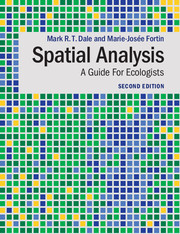Book contents
- Frontmatter
- Dedication
- Contents
- Preface
- 1 Spatial concepts and notions
- 2 Ecological and spatial processes
- 3 Points, lines and graphs
- 4 Spatial analysis of complete point location data
- 5 Contiguous units analysis
- 6 Spatial analysis of sample data
- 7 Spatial relationship and multiscale analysis
- 8 Spatial autocorrelation and inferential tests
- 9 Spatial partitioning: spatial clusters and boundary detection
- 10 Spatial diversity analysis
- 11 Spatio-temporal analysis
- 12 Closing comments and future directions
- References
- Index
4 - Spatial analysis of complete point location data
Published online by Cambridge University Press: 05 September 2014
- Frontmatter
- Dedication
- Contents
- Preface
- 1 Spatial concepts and notions
- 2 Ecological and spatial processes
- 3 Points, lines and graphs
- 4 Spatial analysis of complete point location data
- 5 Contiguous units analysis
- 6 Spatial analysis of sample data
- 7 Spatial relationship and multiscale analysis
- 8 Spatial autocorrelation and inferential tests
- 9 Spatial partitioning: spatial clusters and boundary detection
- 10 Spatial diversity analysis
- 11 Spatio-temporal analysis
- 12 Closing comments and future directions
- References
- Index
Summary
Introduction
In this chapter, we introduce methods for the analysis of completely censused ‘population’ data. Such data can be in one of two formats, a map of individual locations or a map of sample units with area, for each of which we have a summary of population information. The second type of data will be discussed in Chapter 5, and this chapter concentrates on data of mapped point events, which we introduced in Chapter 3 in the context of graph theory and spatial graphs. The map of the locations of all ‘events’, such as individual organisms of a particular species in a study area, may have accompanying information about each event, such as tree height or condition, or may be without such additional information (see Figure 1.3a). We are considering a complete census for the entire extent of the study area, not just a sample, and in most ecological examples the map is in two dimensions, with x–y coordinates to give the positions, but we can also consider one- or three-dimensional maps, with only x or with x–y–z coordinates. We will discuss ways of treating data in both space and time, for example, with coordinates x–y–t, in Chapter 11. The methods for analysing purely spatial point event data can begin with determining the neighbours of each event and then calculating statistical measures based on the distances to those neighbours. An alternative is to have methods based on counting the events in circles of a given range of sizes, or in spatial templates of some other shape. When there is only one category of event, as in studying the spatial structure of a single-species population of mature trees, the analysis is univariate. When two kinds of events are of interest, for example mature trees and the seedlings of a species, the analysis is bivariate. Multivariate analysis applies when there are several categories of events, as in a study of a multispecies forest community. If the events have a quantitative variable associated with them (such as stem diameter), rather than categorical (e.g. the species to which they belong), versions of what is referred to as ‘marked process’ analysis can be used. A detailed and recent treatment of point pattern methods is available in Illian et al. (2008) which provides more mathematical background.
- Type
- Chapter
- Information
- Spatial AnalysisA Guide For Ecologists, pp. 88 - 122Publisher: Cambridge University PressPrint publication year: 2014



